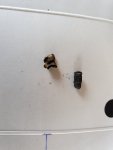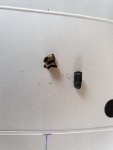Been an owner of Ase Utra Eco can for 2 years now.
I have noticed that cleaning the can has become quite easy after dropping around 5 drops of oil like motor oil into the can before shooting the last magazine. The shots will mix the oil everywhere in the can.
I do not do this every range session, just the one prior to cleaning (every 600-1k rounds or more)
If shooting SV ammo, I have not even smelled burnt motor oil so no, it does not carbonate there.
It keeps the powder from changing into concrete that must be scraped off. It also softens the powder remains that are underneath.
The motor oil is quite water resistant so the cleaning should be done in 2 stages:
1. Remove gunk thats extra. No work needed really, it is soft stuff. If it has tough angles, use wooden stick. Should be enough.
2. Brush it, or if it is not a single body, just wipe the parts with paper or cloth (do not use the curtains)
3. Do not go for perfection, it will be in vain.
I have noticed that cleaning the can has become quite easy after dropping around 5 drops of oil like motor oil into the can before shooting the last magazine. The shots will mix the oil everywhere in the can.
I do not do this every range session, just the one prior to cleaning (every 600-1k rounds or more)
If shooting SV ammo, I have not even smelled burnt motor oil so no, it does not carbonate there.
It keeps the powder from changing into concrete that must be scraped off. It also softens the powder remains that are underneath.
The motor oil is quite water resistant so the cleaning should be done in 2 stages:
1. Remove gunk thats extra. No work needed really, it is soft stuff. If it has tough angles, use wooden stick. Should be enough.
2. Brush it, or if it is not a single body, just wipe the parts with paper or cloth (do not use the curtains)
3. Do not go for perfection, it will be in vain.



